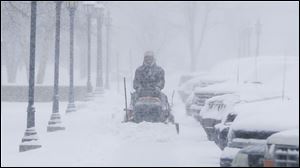
Winter storm blankets Great Plains with snow
Drops more than foot of snow in Kansas; schools, government close
2/22/2013
A man clears snow from the sidewalks around Friends University in Wichita, Kan. as heavy snow falls Wednesday morning.
ST. LOUIS — Blinding snow, at times accompanied by thunder and lightning, bombarded much of the nation's midsection today, causing whiteout conditions, making major roadways all but impassable and shutting down schools and state legislatures.
Kansas was the epicenter of the winter storm, with parts of Wichita buried under 13 inches of still-falling snow, but winter storm warnings stretched eastern Colorado through Illinois. Freezing rain and sleet were forecast for southern Missouri, southern Illinois and Arkansas. St. Louis was expected to get all of the above — a treacherous mix of snow, sleet and freezing rain.
Several accidents were blamed on icy and slushy roadways, including a wreck in Oklahoma that killed a teenager Wednesday. Most schools in Kansas and Missouri, and many in neighboring states, were closed. Legislatures shut down early in Kansas, Missouri, Arkansas, Nebraska and Iowa.
By midmorning today, the snowfall was so heavy that Kansas City International Airport shut down. About 90 flights were also cancelled at Lambert Airport in St. Louis.
“Thundersnow” accompanied the winter storm in parts of Kansas and Missouri, which National Weather Service meteorologist Scott Truett said is the result of an unstable air mass, much like a thunderstorm.
“Instead of pouring rain, it's pouring snow,” Truett said. And pouring was a sound description, with snow falling at a rate of 1 1/2 to 2 inches per hour in some spots.
While heavy in nature, the snow itself is powdery, said weather service meteorologist Suzanna Sortin. She said the Wichita area had received between 11 and 13 inches of snow by midmorning, and places like Salina, Russell and Great Bend were expected to get up to 18 inches of snow.
With that in mind, Kansas transportation officials — and even the governor — urged people to simply stay home. Drivers were particularly warned away from the Kansas Turnpike, as whiteout conditions meant low visibility for the length of the turnpike, from Oklahoma to Kansas City. Interstate 70, which runs the length of Kansas, was also snow-packed and icy.
Kansas Gov. Sam Brownback closed executive offices, except for essential personnel.
“Common sense is a good thing, and we'll make it through it,” Brownback said.
Some travelers gave up, filling hotels rather than skating across dangerous roadways.
At the Econo Lodge in WaKeeney, Kan., assistant manager Michael Tidball said the 48-room hotel was full by 10 p.m. Wednesday and that most guests were opting to stay an extra day. He said travelers reported that snow was freezing on their windshields faster than wipers could keep them clean.
The blowing snow didn't stop everyone. Jesse Landin, feedlot manager at McClymont Feedyard in south-central Nebraska, was out early today clearing a path with his tractor so trucks could put down feed for 11,000 head of cattle, which remained outside.
“They can handle it,” Landin said of the cattle. “They got good winter hair coats.”
Near the Nebraska-Kansas border, as much as 8 inches fell overnight, while western Nebraska saw about half of that amount, National Weather Service forecaster Shawn Jacobs said.
Some parts of Oklahoma also had up to 8 inches of snow by early today, and the weather caused a fatal wreck Wednesday. The Oklahoma Highway Patrol said 18-year-old Cody Alexander of Alex, Okla., died when his pickup truck skidded on a slushy state highway into oncoming traffic and struck a truck.
In northern Arkansas, a school bus crashed Wednesday on a steep, snowy country road, leaving three students and the driver with minor injuries.
The weather service warned that freezing rain could lead to a half-inch or more of ice accumulating today in central and northern Arkansas. The Storm Prediction Center in Norman, Okla., said “significant ice accumulations” are expected in far northern Arkansas.
Missouri Gov. Jay Nixon declared a state of emergency early today and activated the State Emergency Operations Center. The declaration allows state agencies to coordinate directly with cities and counties to provide emergency services. The Missouri Department of Transportation said Interstate 44 near Springfield was completely covered with ice early today, and traffic was moving very slow.
In Jefferson City, Mo., off-duty police sergeant Randy Werner had been perched atop a hotel for more than 24 hours as a publicity stunt for a charitable fundraiser.
As large blowing snowflakes pelted him in the face early today, Werner defiantly declared: “The weather's not bothering me, I can assure you.” He then acknowledged that was a lie.
“It's blustery,” he said. Werner planned to cut his camp out short, having raised less than a third of his goal.
The St. Louis region prepared with some uncertainty. Depending on the temperature and the trajectory of the storm, St. Louis could get snow, freezing rain, ice, sleet or all or some of the above. Crews were hoping to spread enough salt to keep at least the major roadways moving.
National Weather Service meteorologist Jayson Gosselin said precipitation is generally expected to drop off as the storm pushes east. Chicago and parts of Indiana, he said, could get about 2 inches of snow and some sleet.